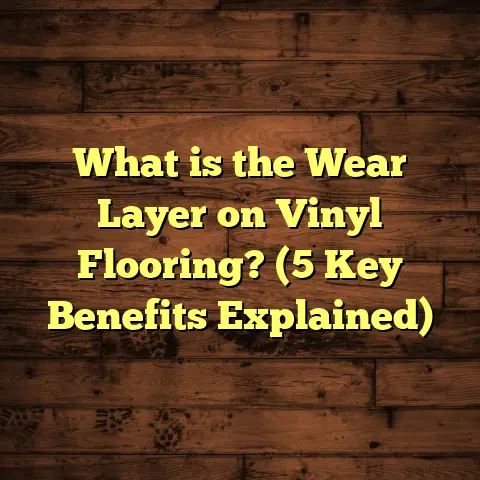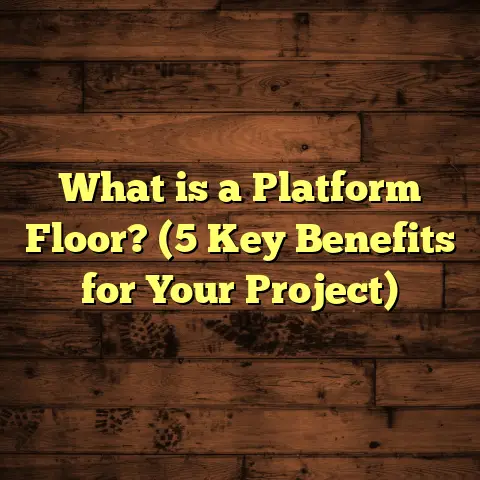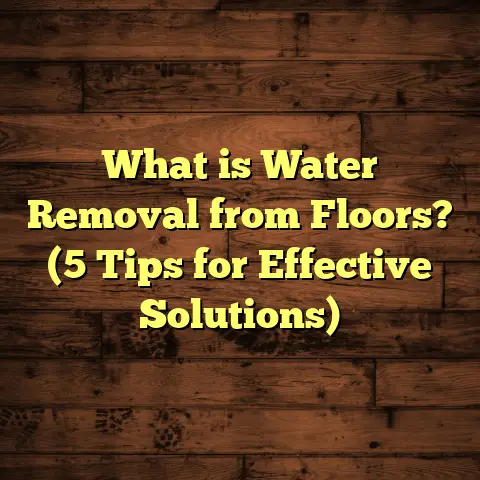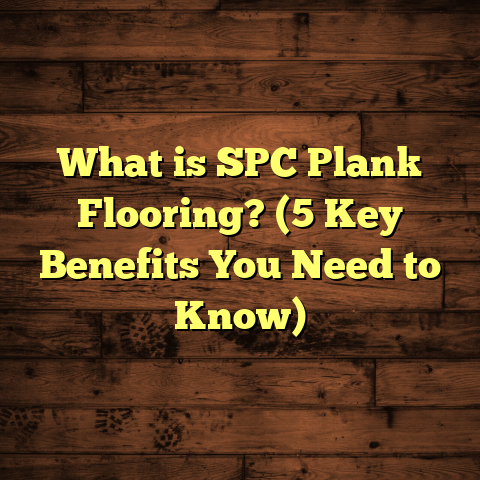What Is Prefinished Engineered Hardwood Flooring? (5 Benefits Revealed)
I once thought installing hardwood floors was going to be a simple weekend project. I had visions of me, tool belt on, hammer in hand, transforming my living room into a cozy paradise. The reality? I spent the first hour trying to figure out how to open the boxes without damaging the planks, then got stuck on how to lay the first few boards right. After a few splinters and a crooked line that made my floors look like a funhouse, I realized that flooring isn’t just about nailing wood down. It’s about choosing the right material, knowing how it behaves, and understanding the finish. Over time, I found that prefinished engineered hardwood flooring has some serious advantages that make life easier for homeowners and contractors alike. Let me walk you through what this flooring is all about, and why it might just be the best choice for your next project.
What Is Prefinished Engineered Hardwood Flooring?
So, what exactly am I talking about when I say “prefinished engineered hardwood flooring?” Let’s break it down.
Engineered hardwood is wood flooring designed to offer the look and feel of solid hardwood but with more stability. Unlike traditional solid hardwood, which is a single piece of wood all the way through, engineered hardwood is made of several layers. The top layer—the one you actually see and walk on—is a thin veneer of real hardwood. Below that are layers of plywood or high-density fiberboard (HDF), stacked crosswise to each other to reduce expansion and contraction when humidity or temperature changes.
This layered construction means engineered hardwood is less likely to warp or buckle compared to solid wood. For homeowners living in areas with humidity swings or even those who want to install over radiant heating systems, engineered hardwood is often a better choice.
Prefinished means all the sanding, staining, sealing, and finishing happens at the factory before the planks ever arrive at your house. The finish usually consists of multiple coats of polyurethane or aluminum oxide applied with high-tech equipment that guarantees a smooth and hard surface.
By contrast, unfinished hardwood requires installation first, then sanding and finishing on-site. That process takes more time, creates dust, smells strong, and can cause uneven finishes if conditions aren’t perfect.
I’ve installed both types many times. Prefinished engineered hardwood saves so much time and hassle without compromising on looks or durability.
My First Experience with Prefinished Engineered Hardwood
I remember early in my career working on a historic home renovation where we switched from solid unfinished wood floors to prefinished engineered hardwood in the kitchen and dining area. The homeowners were concerned about moisture from cooking and spills, so stability was key.
We installed the floor over just two days. No dust clouds or strong odors like I’d seen with unfinished floors. The finish was flawless—smooth with a subtle satin sheen. Months later, the family told me the floors held up great despite heavy use and occasional spills.
That project made me a believer in prefinished engineered hardwood.
Why Does This Matter? The Real-Life Advantages
You might be wondering: Sure, prefinished engineered hardwood sounds convenient, but does it really matter? Is it worth the investment?
To answer this, I focused on five key benefits I see repeatedly in my work and research:
1. Faster Installation Saves Time and Money
When I first started installing floors, sanding and finishing on-site was standard procedure for solid wood. That meant multiple days of work including prep, sanding in stages with different grits, applying stain if desired, then several coats of finish with drying time in between.
This process usually took a full week for an average room—and wasn’t fun for anyone involved. Dust was everywhere, homeowners couldn’t use their rooms for days, and sometimes uneven finishes happened due to varying humidity or poor ventilation.
Prefinished engineered hardwood changed everything.
Because each plank comes finished from the factory with durable coatings already applied under controlled conditions, installation becomes a much simpler job—just laying down the boards.
In fact, industry surveys show installation times are cut by about 40-50% with prefinished engineered floors compared to site-finished solid hardwood.
I’ve personally timed projects where installing prefinished engineered hardwood took half as long as similar-sized projects with unfinished floors. That translates directly to labor savings—and less disruption for homeowners.
2. Tougher Finish Means Longer Wear
One of the biggest surprises for me was how strong factory-applied finishes are compared to what most people expect from traditional site-finished floors.
Prefinished floors often use aluminum oxide coatings—a material also used in industrial abrasives—to provide scratch resistance far beyond typical polyurethane finishes.
In one project for a young couple with two toddlers and a large dog, we installed prefinished engineered oak flooring in their main living spaces. Six months later, they sent me pictures showing minimal wear despite heavy foot traffic and pet claws.
That durability means fewer worries about scratches from furniture or everyday life.
Compare that with site-finished floors where uneven coats or thin finishes can lead to quicker wear spots needing refinishing sooner.
3. Better Stability Makes It Suitable for More Spaces
The layered construction of engineered hardwood means it handles moisture and temperature changes better than solid hardwood.
If your home has basements or rooms above heated garages or radiant heat systems, engineered hardwood is often recommended because it won’t expand or contract as much.
In humid climates or seasons with big swings in moisture levels, solid hardwood can cup or gap noticeably—engineered hardwood resists that better.
I once worked on a beach house renovation where salt air and humidity wreaked havoc on traditional wood floors. Switching to prefinished engineered wood helped keep things looking nice year-round without constant repairs.
4. A Wide Array of Design Options
When first introduced, engineered hardwood options were limited mostly to standard finishes and common species like oak or maple.
Today? The variety is staggering.
Whether you want rustic hand-scraped textures or ultra-smooth glossy finishes; wide planks or narrow strips; light blonde tones or deep walnut browns—there’s something for every style.
Manufacturers now offer exotic woods like Brazilian cherry or hickory as veneers too.
I recently helped a client choose a prefinished engineered floor in a beautiful smoked gray oak finish that perfectly matched their sleek modern kitchen cabinets and quartz countertops.
Because these finishes are factory applied with precision tools, consistency across planks is excellent. There’s less chance of color variation than with on-site staining—great if you want uniformity.
5. Easier Maintenance for Busy Homes
Maintenance is often a big concern for homeowners debating flooring types.
Prefinished engineered hardwood floors are easy to clean because their durable factory finish resists stains and water penetration better than unfinished floors.
Regular sweeping or vacuuming plus occasional damp mopping keeps them looking fresh. Just avoid soaking water or harsh cleaners that can damage finishes over time.
In my experience working with families with pets and kids, these floors hold up well without special treatments or refinishes frequently needed by unfinished wood.
How I Use FloorTally To Help Plan Flooring Projects
Anyone who does flooring projects knows how tricky estimating costs can be. Materials fluctuate depending on species, grade, finish type; labor rates vary by region; waste factors change based on room shape and cut complexity.
Early in my career, I’d spend hours gathering quotes from suppliers, calculating quantities by hand, then guessing labor hours based on past jobs. Mistakes meant ordering too much material (waste) or too little (delays).
Then I started using FloorTally—a handy online tool that streamlines this process by combining local pricing data with customizable inputs like material type, room size, and waste percentages.
I input dimensions from clients’ floor plans along with my prefinished engineered hardwood choices. FloorTally then estimates total material costs plus labor based on local rates I input or choose from its database.
This tool also factors in waste—typically around 5-10% depending on cuts needed—helping me order just enough boards without costly leftovers.
For example: On that beach house project I mentioned earlier (about 850 sq ft), FloorTally showed me exactly how many boxes of prefinished engineered oak planks were needed including waste margin. It also gave me an estimated labor cost based on regional averages for experienced installers.
Sharing this detailed cost breakdown with the client upfront helped manage expectations and avoid surprises once work started.
FloorTally saves me time while increasing accuracy—and it’s become part of my standard workflow now for any flooring job.
Personal Stories From Real Floors
I want to share some real-world examples from projects I’ve worked on that highlight how prefinished engineered hardwood performs differently—and better in many cases—compared to other options.
Story #1: The Family Who Needed Speed and Cleanliness
A family with newborn twins called me when they wanted new floors but were worried about dust and fumes disrupting their sensitive babies’ environment.
We chose prefinished engineered maple because it offered quick installation with no onsite finishing needed. The floor went down in two days flat without any sanding dust or chemical odors lingering afterward.
Mom was thrilled she could have new floors without stressing her babies’ health or waiting weeks for finishes to dry.
Story #2: The Renovation That Beat the Clock
I worked on a historic home where we wanted to replace old worn-out floors quickly so other trades could move in without delay.
Choosing prefinished engineered hickory allowed us to install in half the usual time compared to site-finished solid wood floors. The contractor finished ahead of schedule saving money overall—and the homeowners got gorgeous durable floors that matched the home’s character perfectly.
Story #3: The Pet Owners Who Wanted Durable Beauty
Another couple had three large dogs who loved running around their open living room. Their previous floors scratched easily and showed wear fast.
We installed prefinished engineered oak with an aluminum oxide finish known for scratch resistance. Six months later? Minimal scratches even after daily furry chaos—and they said cleaning was a breeze compared to their old floors.
Some Technical Details Worth Knowing
Let me share some numbers and facts I’ve learned from manufacturers’ specs and industry studies that might help when deciding if prefinished engineered hardwood is right for you:
- Thickness of veneer: Usually between 2mm to 6mm. Thicker veneers allow more sanding/refinishing over lifetime.
- Core layers: Typically 5-7 layers of plywood or HDF underneath veneer.
- Finish coats: Usually 7-10 coats applied at factory.
- Abrasion resistance: Aluminum oxide finishes rank very high on ASTM D4060 tests.
- Installation types: Can be nailed down, glued down, or floated depending on subfloor.
- Lifespan: With proper care, prefinished engineered hardwood can last 20+ years before needing refinishing.
- Cost range: Depending on species and finish, $6-$12 per sq ft materials; installation $3-$8 per sq ft labor varies widely by region.
- Waste factor: Plan for 5-10% extra material based on cuts/waste during installation (FloorTally helps calculate this precisely).
Common Questions I Hear About Prefinished Engineered Hardwood
Can I refinish prefinished engineered hardwood?
Yes—but only a limited number of times depending on veneer thickness (usually 2-3 times max). Thicker veneers give more sanding options. Refinishing requires professional equipment to avoid damaging veneer layer below finish.
Is it waterproof?
No flooring is truly waterproof except vinyl/plastic products. Engineered hardwood resists moisture better than solid wood but still needs prompt cleanup of spills to avoid warping or staining.
How does it compare cost-wise to laminate?
Laminate is usually cheaper upfront but less durable and harder to repair/refinish over time. Prefinished engineered hardwood offers real wood beauty plus longer lifespan—which can mean better value long term if maintained well.
Will it fade in sunlight?
All wood floors fade somewhat with UV exposure; some finishes offer better UV protection than others. Placing rugs or using curtains helps slow fading over years.
Final Thoughts From My Toolbox
Prefinished engineered hardwood flooring combines beauty, durability, speed, and flexibility in ways that fit most modern homes well. It makes installation faster and cleaner while providing tougher finishes that hold up over years—even in busy households with kids and pets.
If you’re thinking about new floors but want something practical without sacrificing style—and want your installer (or yourself) to save time—this product deserves careful attention when comparing options.
I hope sharing my experience helps you feel more confident about whether prefinished engineered hardwood fits your needs! If you want help figuring out costs or styles for your project—or just want tips on installation—feel free to ask anytime.
Would you like me to help you estimate your floor project costs using FloorTally? Or maybe share tips about caring for your new floors? Just let me know!





